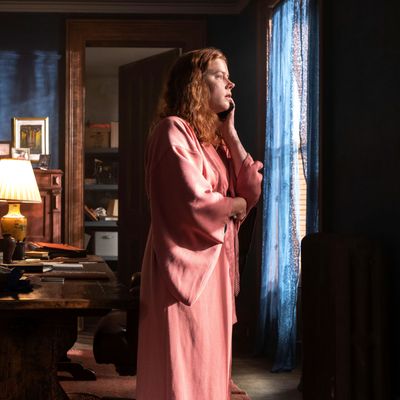
The book isn’t always better than the movie. This has been proven true despite the lingering impression that adaptation is a sloped process, with cultural value trickling downhill from print to screen to, ultimately, dribble at the bottom around a sponsored Snapchat series or something. Sometimes a movie is able to do things a book can’t by letting visuals lead the way. Sometimes a movie streamlines a narrative for the better, smoothing away messy strands and awkward digressions. And sometimes a book just isn’t very good, and the film using it as a basis is able to tease art out of something that wasn’t especially artful to begin with.
Netflix’s The Woman in the Window, which is adapted from a 2018 best seller by Daniel Mallory (using the pseudonym A. J. Finn), does not fall into this last category, though it’s not for lack of trying. In fact, it tries so hard to transmute this formulaic suspense novel into something finer that the twists and turns become almost incomprehensible. It dwells on its main character as though her emotional state were something contradictory and complex and not just an excuse for history’s least surprising reveal. There is something endearing about watching a high-end cast and crew treat this material with such seriousness, even if they all seem to have missed the point. Sometimes schlock is just schlock, and it’s better off treated that way.
And Mallory’s book is schlock, of a majestically cynical kind, conjured up by a book-world exec to take advantage of an unreliable-female-narrator-driven-mystery trend before it waned away. The path that Mallory blazed through the publishing industry, marked by habitual lying and claims of nonexistent cancer, was documented in a 2019 New Yorker article that is itself slated to be made into a movie starring Jake Gyllenhaal. It’s more vivid material than his novel, which reads like the punch line to an outdated meme: “I forced a bot to read Gone Girl, The Girl on the Train, Luckiest Girl Alive, and The Woman in Cabin 10, then asked it to write a book.” Its main character, Anna Fox (played by Amy Adams in the film), is a psychologist whose agoraphobia has kept her indoors for ten months, spending the day drinking, roaming around her cavernous brownstone, and spying on her neighbors on their tony street in the heart of one of Harlem’s historic districts. She sees a therapist (Tracy Letts, who also adapted the screenplay) and talks on the phone with her husband, Ed (Anthony Mackie), who, she informs a rare visitor, is separated from her and has custody of their daughter, Olivia (Mariah Bozeman).
When a family of three moves in across the street, Anna has new people to watch — including the woman of the house (Julianne Moore, doing something a little too close to her 30 Rock voice), who comes to her aid after a panic attack and stays for a drink. Two nights later, Anna thinks she sees that same woman murdered through an upstairs window, though patriarch Alistair (Gary Oldman) insists that nothing has happened. His neighbor, he promises, has never even met his wife, Jane, who is there with him and is played by Jennifer Jason Leigh. Ethan (Fred Hechinger), the troubled teenage son Anna instantly feels protective over, agrees, and the head policeman on the case, Detective Little (Brian Tyree Henry), assumes that Anna’s meds may be causing her to hallucinate.
He’s not wrong, though whether the killing was one of those hallucinations remains the question for Anna. A tenet of the Girl/Woman mysteries is that the title characters aren’t taken seriously — they’re brushed off or gaslighted or radically underestimated, and their solving (or engineering) a mystery becomes a means of proving themselves in the face of. One of the obvious touchstones for The Woman in the Window is Rear Window, which director Joe Wright (of Atonement and Darkest Hour) embraces to the point of styling his film like a Hitchcock pastiche, with a lurid palette and homages in framing. But he also tries to draw a line between his heroine and the hysterical woman in Hitchcock’s oeuvre, to make that connection while also offering a critique.
It would work better if Anna weren’t such a ridiculous character, just a bundle of contrivances in a housedress. Adams has had a particularly rough run of things, between this film and the resentment harpy she played in Hillbilly Elegy, and the trouble here is that she tries to play Anna straight when she ought to be camp — passing out next to an artful arrangement of pill and wine bottles, peeping on everyone with a telephoto camera while never managing to take photos when it would matter most, and tearing apart her house to find her phone in order to call during an emergency. The Woman in the Window wasn’t originally a Netflix production; it was sold off by 20th Century Fox, which had already recut the film after test audiences deemed it too confusing. It does have the feeling of something that was haphazardly pruned. Oldman is seen mostly from afar, while Leigh’s role was almost trimmed out of existence. As Anna’s beleaguered basement renter, David, Wyatt Russell has an oddly truncated arc that makes him feel like he’s there only to add another possible suspect. In cutting down time spent with side characters to focus on Anna, the film also cuts back on the buildup so that the culprit feels chosen at random from the list of possibilities.
The big finale nevertheless remains the best part, because the film goes gleefully off the rails, abandoning characterization in favor of malevolent monologues and operatic violence. It’s almost excessive enough to feel like a fantasy sequence itself — the delusion of a lonely, unraveling person who, as Anna admits herself at a certain point, “just really needed to be at the center of something.” The Woman in the Window may put itself in a tradition of women who are doubted or ignored, but it’s also about a brittle, bored gentrifier who wants to call 311 on a barking dog, who considers reporting the neighbors she barely knows to Child Protective Services, and who barges into her tenant’s space without permission and then tells everyone he’s on parole. There is a moment in the film in which it acknowledges that its protagonist could very well be the villain of the story, and not because she committed a murder. If The Woman in the Window couldn’t commit itself fully to the gleeful trash of its final act, it might as well have gone another route and embraced this much darker reality. As is, it brings together a blue-chip cast and crew to make something that no one involved was apparently able to admit is incredibly silly — and that’s gaslighting on a level Anna and her questionable view could only dream about.





